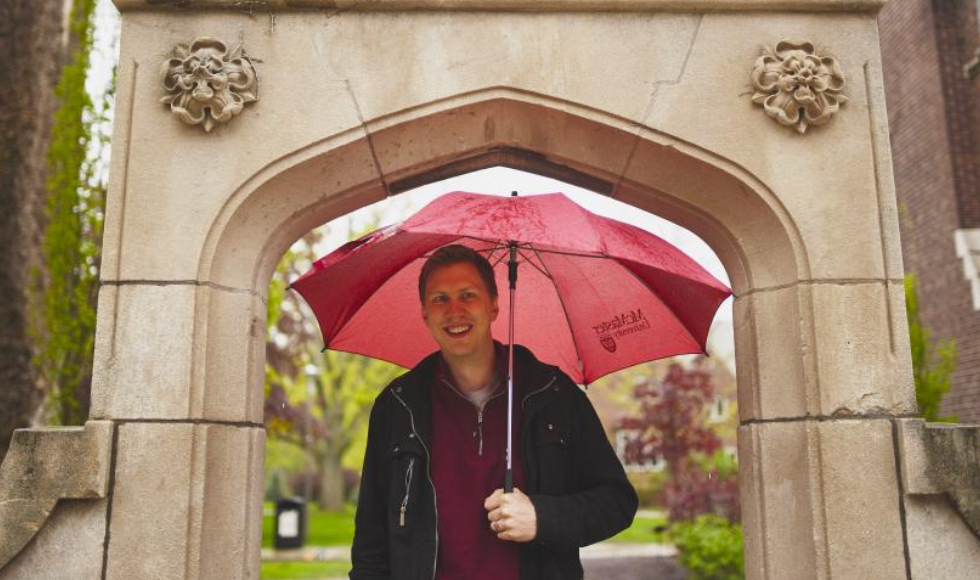Engineering Fresh Faces: Drew Higgins

BY Michelle Pressé
July 16, 2019
Welcome to Fresh Faces. In this series, we highlight new faculty members who are doing interesting and innovative things in the lab and the classroom.
Drew Higgins is an assistant professor in the Department of Chemical Engineering. In his Fresh Faces spotlight, he talks about his love of the wilderness, his idea of perfect happiness and the connection between chemical engineering and hockey.
On the sports and activities he enjoys
I just joined the McMaster Chemical Engineering softball team. But mostly, the sports I play are hockey and basketball. Outdoors, I love hiking — I like exploring and immersing myself in the wilderness. And gardening, making a little bit of wilderness in the backyard of mine and my wife’s townhouse.
On his idea of perfect happiness
Regardless of what day it is or what time it is, if you’re going to work, if you’re leaving work, if it’s a Friday afternoon or Monday morning, you’re satisfied with what you are going to be doing for the next while.
The second component on my idea of perfect happiness is doing something that you find to be rewarding. For me, it’s contributing to the mission of our research program — achieving sustainability of the energy and transportation sectors; while also enabling students to achieve their professional and personal goals in life, whatever those may be.

On what sparked his interest in chemical engineering
Back in high school, I was not the most studious person in the world, but the two subjects I enjoyed were math and chemistry. I talked to my parents in considering what to do in university and combined the two — science and math — and arrived at chemical engineering as a good route.
On the people who inspire him inside and outside of the classroom
Henrik and Daniel Sedin, who are identical twin hockey players. They’re retired now, but they played for the Vancouver Canucks (my favourite team!) through my formative years. They’re outstanding hockey players and incredibly classy. They’re the epitome of what team players should be — always being there to support other people, holding teammates accountable behind closed doors, while having nothing but positive things to say or deflecting blame towards themselves in the public spotlight. I think that they are just excellent examples of how to be successful and be a leader — stay humble, be fully committed to what you do, and carry that team first mentality.
On the connection between chemical engineering and hockey
Everyone has their own personal goals, but as educators, we are here to enable the next generation of students to do great things in the world. It’s that team-first mentality, having a collaborative outlook and being able to work together towards common goals that enables success. The Department of Chemical Engineering and Faculty of Engineering have done a good job of fostering this type of environment, which also ultimately underpins any successful hockey team.

On his research
The research program that our team is launching is looking at catalyst materials — making nanomaterials that can drive chemical conversions. Particularly, we are looking at catalysts for electrochemical reactions, so using electricity to sustainably produce fuels or using clean fuels to produce electricity, like a hydrogen fuel cell for a car. One of the projects we are working on is converting carbon dioxide, using electricity that is ideally from renewable sources, into fuels and chemicals. A key aspect of this research is that the advances that we make will serve to help transition our society towards sustainability.
On what he likes most about McMaster
It’s a really collaborative, supportive environment. I think that having a good environment in terms of the people and the culture is essential for happiness and success. I have a team-first mentality so having people around that have that same philosophy on life is really important. I’ve really been enjoying it.
On a good book he’s read recently
I read a really good book recently called The Alchemy of Air by Thomas Hager. It has a similar theme to the work that my research team does in terms of finding new, efficient (and ideally sustainable) processes to make the chemicals that are important to society. This book tells the story of German scientists working alongside the industrial sector to develop new catalysts and processes to produce fertilizers. This is one of the biggest technological developments of the last century as synthetic fertilizers made by this process allowed for dramatically higher agricultural yields that are used to support the world’s ballooning populations. These activities took place in World War II era Germany, so there are dramatic aspects of the story due to shifting political landscapes and global power struggles. I found this story inspiring as it depicted the trials and tribulations of laboratory based research (something I think that all scientists can relate to); and provides an excellent example of how perseverance and dedication can enable innovations that improve the quality of life for billions of people.


